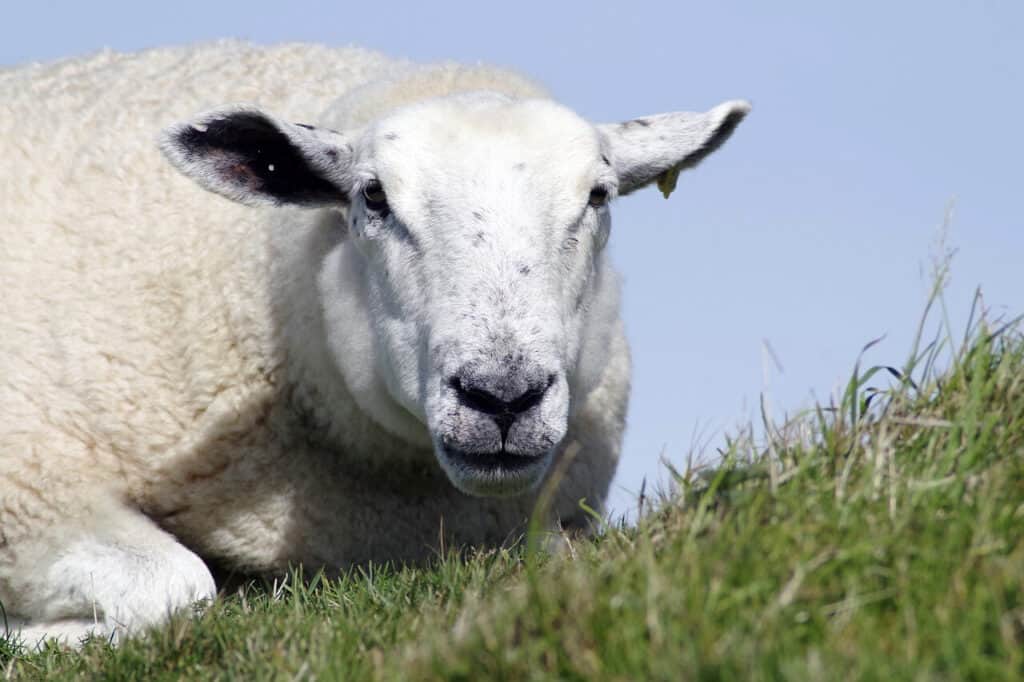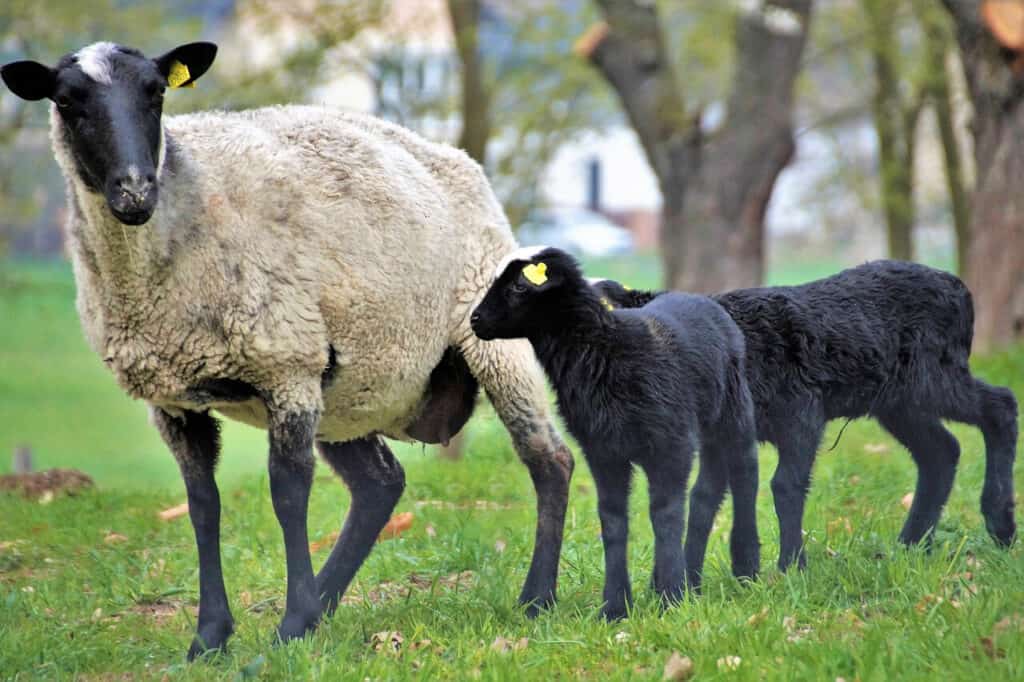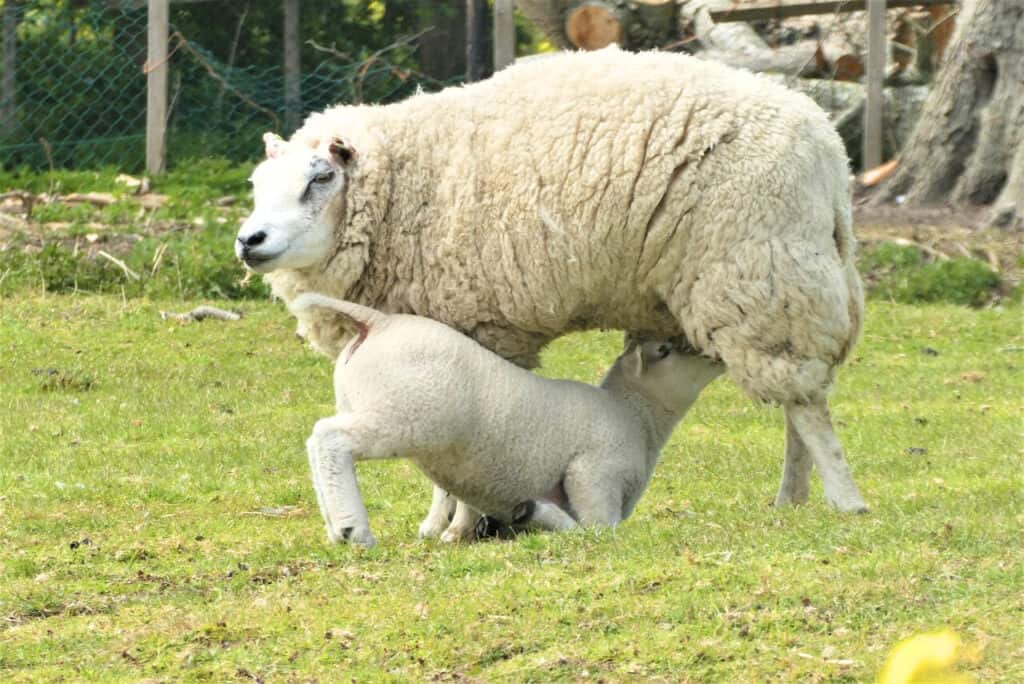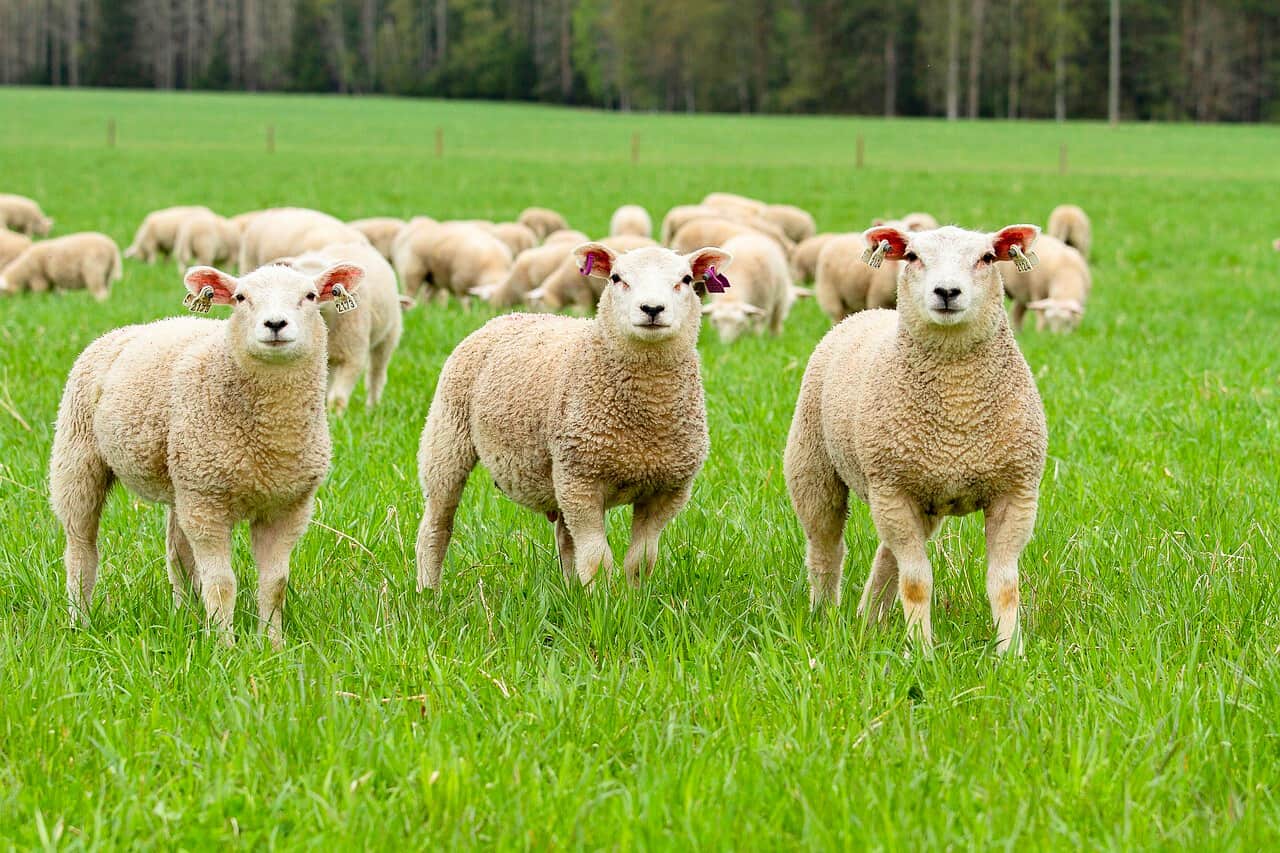Meat sheep breeds are bred specifically for meat production. They have a high growth rate and weight gain, good meat quality, efficient feed conversion, and strong immunity. When raising sheep, choosing the right breed for your climate, land, and goals is important to ensure optimal production and profitability.
People raise sheep for a variety of reasons, including meat, wool, dairy production, conservation grazing, and as pets. If you are primarily interested in meat production, you should choose a breed known for its meat quality and growth rate. Some popular meat sheep breeds include Dorper, Katahdin, and Hampshire. They are hardy and easy to care for, making them a good choice for small-scale producers.
Whether you want to raise sheep on your farm or are just interested, keep reading to learn more about the best sheep breeds for meat.
Characteristics of Meat Sheep Breeds
Meat sheep breeds are distinct from other breeds of sheep due to their unique characteristics. These include:
- High growth rate and weight gain: Meat sheep breeds are fast-growing and can reach market weight in a short period.
- Good meat quality: The lamb and/or sheep meat is usually tender, juicy, and flavorful.
- Efficient feed conversion: They have a high feed conversion efficiency, which means they can convert feed into meat quickly and efficiently.
- Strong immunity: Certain meat sheep breeds are resistant to common sheep diseases and parasites.
Lamb and Sheep Meat
There are several parts of of the animal that people consume. The most popular cuts of lamb and sheep meat and popular ways to prepare them are:
- Shoulder: The shoulder is typically used for slow cooking or braising.
- Rack: The rack is a more tender cut that is often roasted or grilled.
- Loin: Loin, located on the back of the animal, is a leaner cut that is also suitable for grilling or roasting.
- Leg: Leg of lamb is often used for stews or curries, but can also be roasted. Typically, it is called “leg of lamb” rather than “sheep leg” when referring to the meat cut from the hind leg of a sheep.
Lamb meat is typically more tender and flavorful than sheep meat, which can be tougher and stronger in flavor. [1][2]
Popular Meat Sheep Breeds
There are several popular meat sheep you can raise, each with unique characteristics. Some of the most common are:
Dorper
The Dorper breed was developed in South Africa in the 1930s by crossbreeding Dorset Horn and Blackhead Persian sheep. The goal was to create a hardy, meat-producing breed that could thrive in the country’s arid climate. The breed was first introduced to the United States in the 1990. It’s since become a popular choice for meat production.
Dorpers are medium-sized sheep with a muscular build and a distinctive white body and black head. They have a broad, flat nose and long, drooping ears.
Primarily raised for mutton, Dorpers have a high feed efficiency, which means they can convert feed into muscle quickly and efficiently. This results in a high-quality meat with a mild flavor and tender texture. Dorper meat is lean. [3]
This meat breed is fertile with a long breeding season. They are also hornless. Dorpers are hardy and adaptable and can thrive in a variety of environments. They can be a good choice for small-scale producers.
Dorper sheep are well-suited for arid and semi-arid climates. They can also adapt to other environments, including humid and cold climates, as long as they have access to shelter and adequate feed and water. They are resistant to parasites as well. [4]
Reasons to raise:
- Hornless, easy to handle
- Adaptable to different climates
- Resistant to parasites
Katahdin
The Katahdin Hair Sheep International describes the Katahdin as a “medium-sized, low-maintenance breed” that produces high-quality meat.
Katahdins are a breed of hair sheep developed in the United States in the 1950s. They do not produce wool. They are the result of crossing various British meat sheep breeds with hardy, disease-resistant Caribbean hair sheep.
They have a distinctive reddish-brown coat and are known for their hardiness and adaptability. Katahdins are medium-sized sheep with a muscular build and a meaty conformation. [5]
Primarily raised for meat production, the Katahdin breed is known for producing high-quality meat with a mild flavor and tender texture. The meat is lean. [6]
Reasons to raise:
- Hardy and adaptable to harsh and cold climates.
- Low maintenance
Hampshire
The Hampshire sheep breed originated in Hampshire, England, in the early 1800s. They were bred by crossing local down breeds with Southdown and Leicester rams. Hampshire sheep were first imported to the United States in the mid-1800s and became popular for their fast growth and meat production. [7]
Hampshire sheep have black faces and legs with white wool. The wool is medium length. Hampshires are a medium-to-large breed. Rams weigh approximately 225 – 275 pounds and ewes weigh between 175 – 225 pounds. Hampshire sheep are known for their strong, muscular bodies and broad shoulders. [8]
They produce high-quality, tender, lean meat with a with a good meat-to-bone ratio. This breed is often used in crossbreeding programs to improve meat quality in other breeds. [9]
Although Hampshire sheep will adapt to a wide range of environments and climates, they are well-suited to areas with moderate to cool temperatures and adequate rainfall. They can also thrive in more arid regions if provided with adequate forage and water. [10]
Reasons to raise Hampshire sheep for meat:
- Fast growth
- High fertility rates
- Hardy, resilient
Cons to raising:
- May show aggressive behavior
- Can be susceptible to foot rot. [11]

Dorset
The Dorset breed originated in the southwestern counties of England. It was developed primarily as a meat sheep. Dorsets were first introduced to the United States in the early 1800s, and the breed was later imported to Australia, New Zealand, and other countries. [12] [13]
They are medium-sized with a white wool and a pink nose and ears. Both rams and ewes have horns. They are known for their early sexual maturity and ability to breed out of season. The breed is favored by many farmers for its fast growth and efficient conversion of feed to meat. [14][15]
Their meat is mild and tender. With proper care, Dorset sheep thrive in a variety of climates and environments, including cold and wet climates.
Reasons to raise:
- Adaptable
- High lambing rate
- Docile, easy to handle

Suffolk
Suffolk sheep originated in England in the early 19th century, specifically in the counties of Suffolk and Norfolk.
The breed was developed by crossing Norfolk Horned rams with Southdown ewes. The breed was first introduced to the United States in the late 1800’s/early 1900’s. [16][17]
Suffolk sheep are considered a large breed. Rams weigh between 250 and 350 pounds and ewes weigh between 180 and 250 pounds. They have black faces and legs and white wool.
This renowned meat sheep breed produces high-quality, lean, tender meat with a good meat-to-bone ratio and distinctive flavor. [18][19]
The Suffolk sheep is best suited for temperate climates and can adapt to a range of environments. Suffolk sheep are adaptable to a variety of environments and climates, and can thrive in both hot and cold temperatures. They are commonly raised in the United States, Australia, and New Zealand.
Reasons to raise:
- Hardy
- Easy to manage
Disadvantages to raising:
- Large sheep breed
- Can become aggressive toward other sheep
- May need increased fencing
- May have lower lambing rate than other breeds
Texel
The Texel sheep breed originated on the Dutch island of Texel in the North Sea, off the coast of the Netherlands. The breed was developed in the early 1900s by crossbreeding local sheep with Leicester Longwool and Lincoln breeds.
This meat sheep breed is now considered one of the most popular sheep breeds in Europe and has also gained popularity in North America and other parts of the world. [20][21]
This sheep is medium-sized with a muscular, rectangular body and a broad, deep chest. They have a distinctive appearance due to their short, fine wool and a large, meaty frame. They have a black nose and short, upright ears. Their wool is typically white. [22][23]
Texel sheep are known for producing high-quality meat with a lean, tender texture and a mild flavor. The breed is known for its large loin and leg muscles, which are well-suited for meat production. Texel lamb is prized for its superior taste and texture. [24] [25]
Texel sheep are adaptable to a range of environments and climates, but they are often raised in temperate regions with moderate rainfall. They can tolerate cold weather and harsh winter conditions but require shelter from heavy rain or extreme heat. Texel sheep are also known for their ability to thrive on pasture-based systems and can be raised in a variety of production systems, from small-scale homesteads to large commercial operations. [26][27]
Reasons to raise:
- Ability to produce high-quality meat
- Adaptability to a range of climates and environments
- Docile temperament
- Easy to handle
Disadvantages:
- Can be prone to health issues such as foot rot and internal parasites
- Heavy muscling can make lambing more difficult [28][29]
Southdown
The Southdown breed originated in southeastern England, where it was developed for meat and wool production in the 1700s. The breed was imported to the United States in the early 1800s and quickly became popular for its excellent meat quality and hardiness in a variety of climates. [30] [31]
Southdowns are small to medium-sized sheep with a compact and muscular body. They have a distinctively round, apple-shaped head and a short, woolly fleece that can be white, gray, or tan. Rams weigh around 225 pounds, while ewes weigh approximately 140 pounds. [32][33]
The breed is known for producing a well-marbled, lean meat with a mild flavor. Southdown lamb is regarded for its flavor, tenderness, and juiciness, making it a popular choice for high-end restaurants and gourmet markets. [34][35]
Southdown sheep are adaptable to a wide range of environments, from hot and humid to cold and dry.
They are particularly well-suited to grazing on marginal land, and can thrive on a diet of grass and other forage. [36][37]
Advantages to raising:
- Hardiness, adaptability to a wide range of climates
- Excellent meat quality
Disadvantages to raising:
- Small size may make them less profitable for commercial meat production compared to larger breeds. [38][39]
Other Meat Sheep Breeds
- Blackbelly Barbados sheep
- Charollais
- Cheviot
- Montadale
- North Country Cheviot Sheep
- Oxford
- Shropshire
- Teeswater
- Tunis
Factors to Consider When Choosing a Meat Sheep Breed
Choosing the right meat sheep breed for your operation depends on several factors, including:
Environment: Some breeds are better suited for specific environments than others. Consider the climate, topography, vegetation, and space of your area when choosing a breed.
Production goals: Determine your production goals, such as weight gain, growth rate, and lambing rate, and choose a breed that aligns with these goals. Do you want to raise meat to feed your family and/or to sell?
Market demand: Different markets may prefer specific meat sheep breeds. Research local and regional demand for different breeds and their meat qualities. This will help you determine which breed to raise and the best market to sell your meat.
Management practices: Some breeds require more management and care than others. Consider your level of experience and resources when choosing a breed. You may want to purposely choose a docile breed if you are beginning in caring for livestock.
Production costs: Consider the cost of feed, vaccines, and other supplies needed to raise the animals. It’s important to keep track of expenses to ensure that you’re not spending more than you’re earning.

Raising Sheep for Meat on a Small Farm
Raising meat sheep breeds on a homestead can be a rewarding experience. Sheep are a great source of meat, are generally easy to raise, are hardy animals that can adapt to a variety of environments, and require minimal care.
Raising a flock can be a way to help you reach your sustainability goals. However, as with caring for livestock, sheep require time and effort. It’s important to consider several factors to ensure a successful and profitable operation.
Basic care includes:
- Proper nutrition: access to clean water, adequate forage, appropriate feed
- Shelter, protection from predators and weather
- Regular health checks: vaccinations and deworming
If you’re raising meat sheep for a family of four, you’ll need to raise at least 2 – 4 animals per year. This will provide enough meat for your family for a year, assuming an average consumption of 60 to 70 pounds of meat per person per year. Sheep owners will often cull their ewes after their spring lambing season.
Determine if you want to breed sheep yourself. Two ewes and a ram will give you the opportunity to be self-sufficient. Learn how long are sheep pregnant. If so, you will also need to learn how to breed sheep and raise newborn lamb. The other option is to purchase lambs from other farms. How much does a sheep cost
Pros and Cons to Raising
Raising sheep for meat can be worthwhile, but consider the following pros and cons.
Pros:
- Great source of high-quality meat.
- Hardy and can adapt to a variety of environments
- Easy to raise and require minimal care
Cons:
- Significant amount of space for grazing; learn how many sheep per acre so you can have a healthy flock
- Can be prone to certain health issues, such as parasites and respiratory infections
- Require fencing to keep them contained and to protect from predators (such as coyotes). Learn how long do sheep live
FAQs
Which sheep are best for meat?
The best sheep for meat depend on the specific needs and preferences of the farmer, such as climate, available resources, and desired traits. Katahdin, Hampshire, Southdown, Suffolk, Texel, and Dorpers are popular.
What is the meatiest sheep breed?
The meatiest sheep breed is the Texel, known for its muscular build and high meat-to-bone ratio. [40]
What are the 3 types of sheep meat?
The three types of sheep meat are lamb, hogget, and mutton, which differ in age and tenderness. Lamb refers to meat from a sheep that is under one year old. Hogget is from a sheep that is between 1- 2 years old. Mutton is from a sheep that is 2+ years old.
What is the best eating lamb?
The best eating lamb can be subjective and depend on personal preferences, but some popular breeds for their meat quality include Katahdin, Dorper, and Hampshire.
Conclusion
Raising domestic sheep can be a way to have a sustainable meat source on your homestead. Meat sheep breeds were bred specifically to yield flavorful, tender, high-quality meat. They differ from breeds that were bred for milk or wool. Learn more about sheep vs lamb and how their meat differs.
If you have grazing area, sheep may be a good fit for your property. Sheep are social animals and get along with goats, llamas, horses, and chickens. Herding dogs can help contain and protect your flock.
Sheep require the normal amount of care — food, water, shelter, health maintenance, protection from predators — and are easy to raise. There are some meat breeds better suited to certain climates; however, most all of them are very hardy, adaptable, and resilient. Consider these sheep names for your flock.
Whether you are new to homesteading and raising livestock or are adding to your existing operation, considering sheep and other animals are a way to live sustainably.
References:
[1] American Lamb Board
[2] Sheep101
[3] The Livestock Conservancy: Dorper
[4] UC Davis Animal Science: Dorper Sheep
[5] [6] University of Maine Cooperative Extension and Katahdin Hair Sheep International: Breed History
[7] [10] Oklahoma State University – Breeds of Livestock: Hampshire Sheep History and Hampshire Hardiness
[8] Sheep101 – What Do Hampshire Sheep Look Like
[9] American Sheep Industry Association – Hampshires used for crossbreeding
[11] Sheep101 – Hampshire foot rot
[12] [14]Oklahoma State University: Dorset sheep
[13] American Dorset Sheep Breeders’ Association History of Dorset Breed
[15] American Dorset Sheep Breeders’ Association: About the Dorset Breed
[16] [18] “Suffolk Sheep.” Oklahoma State University, Department of Animal and Food Sciences afs.okstate.edu/breeds/sheep/suffolk.
[17] [19] “Suffolk Sheep.” The Livestock Conservancy
[20] Texel Sheep Society. “History of the Texel Breed.”
[21][28] Oklahoma State University. “Texel Sheep.”
[22][24][27][29][40] American Texel Sheep Breeders Society
[23] The Livestock Conservancy. “Texel Sheep.”
[25][26] Sheep101.info. Texel Sheep
[30] The Livestock Conservancy. Southdown
[31] [33][39] Oklahoma State University. Breeds of Livestock – Southdown Sheep
[32] [34] [36] [38] The Livestock Conservancy. Southdown
[35] [37] American Southdown Breeders Association
Featured image credit: Päivi Nietosvaara, Pixabay

